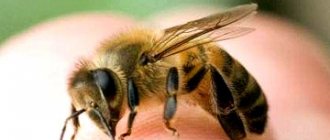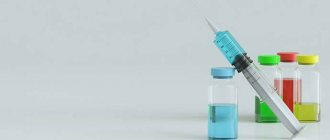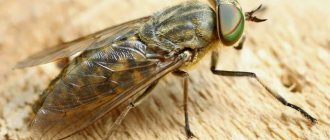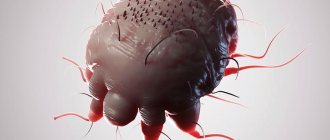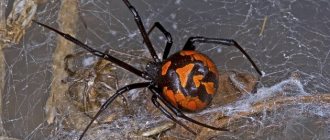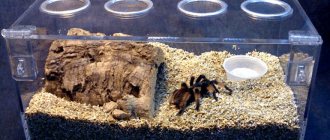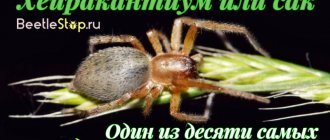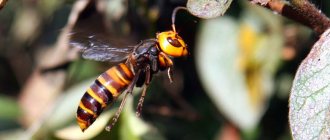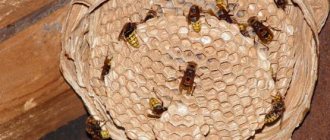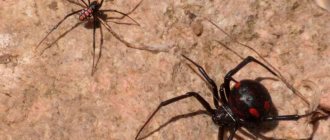Surely most people have encountered a wasp sting at least once in their lives. This event is definitely not the most pleasant. However, no one is protected from a sudden attack from this fairly common type of insect. Redness, severe and acute pain, itching and swelling. Above were presented the most basic consequences that a wasp sting can lead to. In fact, this event must be taken seriously, because as a result of an attack by a wasp, more severe consequences can occur even for the body of an adult.
Signs of a wasp sting
A wasp sting can be recognized by three main signs:
- very sharp pain occurs;
- the bite site swells;
- Redness of the skin appears around the bite site.
And for most people, this is where it all ends; soon the unpleasant sensations go away - usually after 2 - 3 hours. But 1% of victims experience a severe allergic reaction, which can be fatal. Symptoms of a dangerous condition look like this:
- the swelling is very strong and increases rapidly;
- a rash and itching appears throughout the body;
- nausea and vomiting begin;
- it becomes difficult to breathe;
- the pulse is unstable - either too fast or, conversely, slow;
- dizziness appears.
Ultimately, the person may lose consciousness.
To the point
Midge, mosquito, tick and bee bites: how to provide first aid?
Application in cosmetology
Some substances that make up wasp venom have antiseptic, bactericidal, anti-inflammatory, and analgesic effects. The components promote skin rejuvenation, smoothing out wrinkles and restoring the natural epithelial layer. Despite the fact that a wasp sting is harmful to humans, the beneficial properties after processing the poison are actively used in cosmetology.
A properly processed composition of the wasp's biological secretion acts like Botox . Being a natural component, it does not have a chemical effect on the skin, due to which wrinkles are effectively eliminated and the skin maintains a fresh, healthy appearance.
In modern cosmetology, many drugs have been developed that have a beneficial effect on the skin. Therefore, wasp venom can have both detrimental and positive effects on the human body.
First aid for a wasp sting
First of all, inspect the wound to see if there is a sting left there. Wasps, unlike bees, have a sting that is not jagged, it is smooth, so insects pull it out and can bite several times in a row. But sometimes it happens that the sting still remains. If it's in the wound, pull it out. It's best to use tweezers or something similar. But under no circumstances try to squeeze it out like a pimple - this will introduce even more poison into the body, and you can even get an infection.
Next steps are:
- disinfect the wound with hydrogen peroxide or vodka;
- wrap the bite site with a sterile bandage - the bandage will prevent the poison from spreading throughout the body;
- apply ice - it will relieve pain;
- take any antihistamine;
- drink a lot of water and go to the toilet more often - this will remove the poison from the body faster.
Stay up to date
Anaphylactic shock: what is the insidiousness of this condition?
Features of bee stinging
When prescribing a course of treatment, the doctor must take into account not only the condition of his patient, but also the age of the bee, which directly affects the composition of its venom. In medicine, there are specially developed methods that make it possible to understand what dose of poison is indicated for a patient of a given age suffering from a specific disease.
Preventing wasp stings
A wasp can bite anywhere – both in nature and in the city. You need to be especially careful in the following cases:
- when you throw garbage into a street container, there is often food there, and where there is food, there are wasps;
- near grocery stores and street food outlets - wasps flock there, attracted by the smell of food;
- on a picnic in nature - before you put a piece of food into your mouth, especially barbecue or sweets, carefully examine it;
- in the garden, at the end of July - August, when fruits begin to ripen, wasps often feed on them;
- in a country house - wasps often fly inside, again, attracted by the smell of delicious things: hang mosquito nets on the doors and windows;
- in bathhouses, barns, attics - wasps build nests in these places;
- when weeding grass and pruning bushes, some types of wasps make nests on plant shoots and in the crown.
Set of apitherapy methods
According to the principles of apitherapy, all products created by bees are beneficial to human health:
- Honey is the most famous product. Used for colds, inflammation, loss of energy, etc. It can be used for massage and wrapping.
- Propolis – used by bees as a disinfectant. In folk medicine it is used to destroy bacteria and prevent their spread.
- Royal jelly is a very nutritious product. Used in cosmetics, as a food additive, and in pharmaceuticals.
- Bee bread (fermented pollen) – has a positive effect in the fight against allergies, asthma and inflammation.
- Wax is the least active substance. The aroma of candles helps with respiratory diseases.
- Poison - treatment with bee stings acts against rheumatism, tennis elbow, dissolves some unwanted substances deposited in the joints, etc.
Beekeeping, although not a product, has a positive effect on health, especially mental health.
How exactly can bees be used?
Apitherapy procedures are applied taking into account the specific disease.
Bee sauna
Lying on a wooden board from a beehive without a mattress helps with mental problems. This procedure reduces hyperactivity, improves heart function, and calms breathing. It is often used for hyperactive children or ADHD.
Apibanya
Apiespiration
Breathing air directly from the hive helps people with difficulty breathing. Overall, this procedure strengthens the body.
Honey massage
Classic honey massage cleanses and softens the skin without opening the lymph. Detoxifying massage is more demanding on the body. It may take several hours. This massage increases blood pressure and is therefore not very suitable for people with hypertension.
Honey massage
Bee venom
It is used to treat rheumatism, strengthen the body's defenses, and eliminate disorders of the peripheral nervous system using direct bites.
Bee venom: benefits and harms
To protect its life and the life of its family, each working individual has a sting and a sac of poison connected to it - a transparent yellowish liquid with a specific taste and smell. Since the poison has a high solids content (up to 40%), it dries quickly in air. However, this same property gives it a long lasting effect.
Bee venom can be a medicine in skillful hands due to its rich composition:
- Pheromones;
- Proteins (enzymes);
- Peptides;
- Biologically active amines (including histamine);
- Sahara;
- Lipids;
- Amino acids;
- Minerals: carbon, nitrogen, hydrogen, magnesium, calcium, phosphorus, copper, etc.
The main part of the poison is represented by enzymes and peptides. It is these two groups that play a decisive role in influencing the human body.
The most important components of apitoxin (bee venom) are:
- Cardiopeptide – stabilizes the cardiovascular system;
- Adolapine – has an analgesic effect;
- Melitin – has anti-inflammatory and antibacterial effects;
- Apamin – stimulates the nervous system, normalizes metabolism. Prevents a decrease in blood clotting;
- Histamine and acids - dilate blood vessels, lower blood pressure.
All these properties make it possible to use bee venom in the treatment of a number of diseases: gout, neuritis, arthritis, neuralgia, osteochondrosis, vertebral hernia, radiculitis, arrhythmia, angina pectoris, varicose veins, thrombophlebitis, chronic bronchitis and even bronchial asthma. Positive results have been obtained using apitoxin in the treatment of patients after stroke and paralysis.
The effect of beneficial substances in bee venom is inseparable from the influence of the harmful components it contains. Therefore, in some cases, treatment with apitoxin is prohibited. Contraindications to bee stinging are:
- Allergy. And not only for bee venom, but also for other bee products;
- Pregnancy or lactation period;
- Oncological diseases;
- Acute form of the disease or exacerbation of a chronic one;
- Infectious diseases, as well as conditions with increased t;
- Poor blood clotting;
- Ages up to 14 years, when the immune system is not yet fully formed;
- Pathological conditions of the liver, kidneys, as well as tuberculosis.
Important! Depending on the doses used and the sting points, the effect of bee venom can be therapeutic or poisonous. That is why treatment with bee stings should be carried out with the assistance of a specially trained apitherapist. In this case, the benefit of a bee sting will be the result of a precisely calculated effect.
What to do
Most likely, specialized treatment will not be needed. However, if you experience unbearable pain and severe itching, you can try the following natural remedies to relieve swelling from a midge bite.
Rinse thoroughly
It is important to wash the area well with soap and water to avoid bacterial infection or, worse, Morgellons syndrome. Dry with blotting movements without rubbing.
Biting midges have four sharp blades in their mouths that tear the skin, leaving a small open wound susceptible to infection.
After thoroughly cleansing your skin, apply an antiseptic.
Apply apple cider vinegar
Vinegar is a popular natural home remedy that is used for a variety of purposes. It will help reduce swelling, pain, and redness. Soak a cotton swab in a little vinegar (1 part water to 1 part vinegar) and gently apply it to the area until it starts to feel better.
Apply a cold compress
If a midge bite causes swelling and unbearable itching, you may find some relief by applying a cold compress. Add some ice to a damp cloth and place it on the wound. Keep it on the affected area for at least 15 minutes.
The cooling sensation will reduce swelling, numbness of the skin, and relieve itching. Do not apply ice directly to the skin or leave the compress on for more than 20 minutes.
Use anti-itch cream
There are a huge number of pencils, sprays, balms that relieve itching, burning, and pain. Over-the-counter creams such as Cortizone-10 contain hydrocortisone.
Hydrocortisone is a chemical compound that temporarily relieves the itching associated with insect bites. Many creams contain aloe, which helps soothe and moisturize the skin.
Find out more 21 reasons for itching, find out why your head itches
Essential oils
Essential oils are an excellent treatment for insect bites. With a few drops you can quickly get rid of swelling and itching. Some will help prevent infection.
The best essential oils for midge bites:
- Lavender;
- Lemon balm;
- Tea tree;
- Chamomile;
- Thyme;
- Mint;
- Eucalyptus.
It is important to remember that oils are extremely effective and should never be applied directly to the skin. Before using, you need to make sure that you dilute it with a quality carrier oil such as coconut, jojoba, almond.
They are great for repelling midges, midges, and other annoying pests.
Take aspirin
Aspirin is a treatment that reduces inflammation associated with midge bites and also helps reduce swelling and itching. Use the back of a spoon to crush the aspirin and mix it with a little water to form a paste. Apply the paste to the injury site and leave for ten minutes.
Take a cold shower
If you're dealing with multiple bites, taking a cold shower for ten minutes will help you feel better. Cold water reduces swelling from midges and other insects.
Helpful information
Bee venom in small doses is a medicine, but in large quantities it causes intoxication. The threshold at which it causes poisoning is relatively high: in healthy men it is 700-1000 bites, in women slightly less, and in children up to 90 bites. The exception is people with an allergy to apitoxin (about 1% of the population), who have zero tolerance.
This fact must be kept in mind. Firstly, do not underestimate bee venom, which in exceptional cases can have fatal consequences. Secondly, to prevent fear of him. Indeed, according to the latest scientific data, it is an excellent therapeutic agent.

